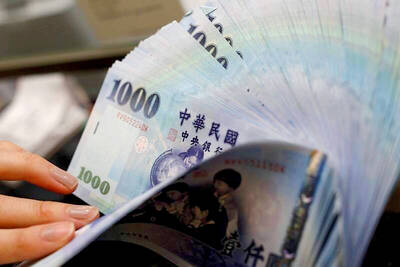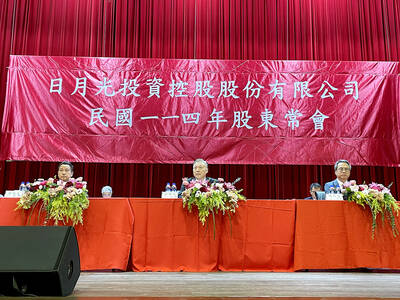An Australian man went on trial in London this week over his claims of inventing bitcoin — not the first time someone has been linked to being the cryptocurrency’s enigmatic creator.
Computer scientist Craig Wright, 53, says he is “Satoshi Nakamoto,” the pseudonym of bitcoin’s creator and author of a white paper that introduced the cryptocurrency to the world in 2008.
He is being sued by cryptocurrency activists who say he has lied and forged documents in his attempts to pretend he is bitcoin’s founder.

Photo: AFP
Bitcoin saw its popularity skyrocket to become the largest cryptocurrency, and now has a market capitalization of US$880 billion, pricing data site CoinGecko showed.
However, after collaborating with fellow developers to finesse the code, the mysterious Satoshi disappeared from the radar in about 2011. Multiple theories have since emerged regarding his identity:
Hal Finney
US developer and cryptographer Hal Finney was the first person to receive the virtual unit, when Satoshi himself sent him 10 bitcoins as a test.
However, in October last year, the theory that Finney was in fact Satoshi was discredited by a high-profile blogger in the crypto community.
The amateur sleuth said he unearthed evidence suggesting that Finney, who died in 2014, was taking part in a running race at a time when Satoshi had been answering e-mails and carrying out bitcoin transactions, thereby ruling him out.
Dorian Nakamoto
Japanese-American engineer Dorian Nakamoto was among the first to be suspected of shaking up the world of currency, following a report in 2014 by Newsweek magazine that he was behind the digital token.
“I am no longer involved in that and I cannot discuss it. It’s been turned over to other people. They are in charge of it now. I no longer have any connection,” he was quoted as saying by Newsweek.
He has since denied being Satoshi Nakamoto.
Back in 2012, bitcoin’s shadowy creator had claimed to be a 37-year-old man living in Japan, according to a profile posted online. Yet critics cast doubt on this hypothesis, citing Satoshi Nakamoto’s excellent English and typically British turns of phrase.
Nick Szabo
Szabo, a US computer scientist of Hungarian origin, was among the early adopters of decentralized cryptocurrencies and was named by a blogger in 2013 as a possible candidate to have created bitcoin.
However, industry insiders argue that there is no tangible proof that he is Satoshi, beyond circumstantial evidence.
Craig Wright
Wright has been on trial this week at London’s High Court, with proceedings expected to last until mid-March.
The enigmatic Australian programmer describes himself on X as “Creator of Bitcoin” and insists he has the required skills and knowledge to have invented it.
Crypto Open Patent Alliance (COPA), a non-profit organization set up to keep cryptocurrency technology free from patents, is suing Wright over his claims first made in 2016.
COPA accuses Wright, nicknamed “Faketoshi” by detractors, of lying about his identity and of forging and manipulating documents.
Wright has been involved in a number of lawsuits brought by himself, but this time around is being asked to defend himself.
Elon Musk
The richest man in the world has also been in the frame, after a former intern at his SpaceX company wrote a series of articles speculating that Satoshi was in fact Musk.
The ex-intern, writing on Medium Web site, claimed the billionaire uses similar language and expressions to those given by Satoshi, adding that a close colleague of Musk seemed too embarrassed to discuss it.
However, tech-savvy Musk rejected the allegations in late 2017 in the face of such meager evidence.
Uncertainty prevails
Despite feverish speculation, uncertainty reigns supreme.
Some commentators argue that a work of such scope and complexity as bitcoin could only be the work of a group of people, rather than a single developer.
Others say that it is highly likely the real Satoshi Nakamoto is either dead — or wishes to preserve the integrity of bitcoin’s collective ethos by maintaining his own anonymity.
Satoshi Nakamoto meanwhile still possesses about 980,000 bitcoins, according to industry researcher Sergio Lerner.
If the bitcoin king is alive, and decides to cash in, that could potentially crash the cryptocurrency because they are together worth about US$44 billion at current prices.

Merida Industry Co (美利達) has seen signs of recovery in the US and European markets this year, as customers are gradually depleting their inventories, the bicycle maker told shareholders yesterday. Given robust growth in new orders at its Taiwanese factory, coupled with its subsidiaries’ improving performance, Merida said it remains confident about the bicycle market’s prospects and expects steady growth in its core business this year. CAUTION ON CHINA However, the company must handle the Chinese market with great caution, as sales of road bikes there have declined significantly, affecting its revenue and profitability, Merida said in a statement, adding that it would

RISING: Strong exports, and life insurance companies’ efforts to manage currency risks indicates the NT dollar would eventually pass the 29 level, an expert said The New Taiwan dollar yesterday rallied to its strongest in three years amid inflows to the nation’s stock market and broad-based weakness in the US dollar. Exporter sales of the US currency and a repatriation of funds from local asset managers also played a role, said two traders, who asked not to be identified as they were not authorized to speak publicly. State-owned banks were seen buying the greenback yesterday, but only at a moderate scale, the traders said. The local currency gained 0.77 percent, outperforming almost all of its Asian peers, to close at NT$29.165 per US dollar in Taipei trading yesterday. The

RECORD LOW: Global firms’ increased inventories, tariff disputes not yet impacting Taiwan and new graduates not yet entering the market contributed to the decrease Taiwan’s unemployment rate last month dropped to 3.3 percent, the lowest for the month in 25 years, as strong exports and resilient domestic demand boosted hiring across various sectors, the Directorate-General of Budget, Accounting and Statistics (DGBAS) said yesterday. After seasonal adjustments, the jobless rate eased to 3.34 percent, the best performance in 24 years, suggesting a stable labor market, although a mild increase is expected with the graduation season from this month through August, the statistics agency said. “Potential shocks from tariff disputes between the US and China have yet to affect Taiwan’s job market,” Census Department Deputy Director Tan Wen-ling

UNCERTAINTIES: The world’s biggest chip packager and tester is closely monitoring the US’ tariff policy before making any capacity adjustments, a company official said ASE Technology Holding Inc (日月光投控), the world’s biggest chip packager and tester, yesterday said it is cautiously evaluating new advanced packaging capacity expansion in the US in response to customers’ requests amid uncertainties about the US’ tariff policy. Compared with its semiconductor peers, ASE has been relatively prudent about building new capacity in the US. However, the company is adjusting its global manufacturing footprint expansion after US President Donald Trump announced “reciprocal” tariffs in April, and new import duties targeting semiconductors and other items that are vital to national security. ASE subsidiary Siliconware Precision Industries Co (SPIL, 矽品精密) is participating in Nvidia